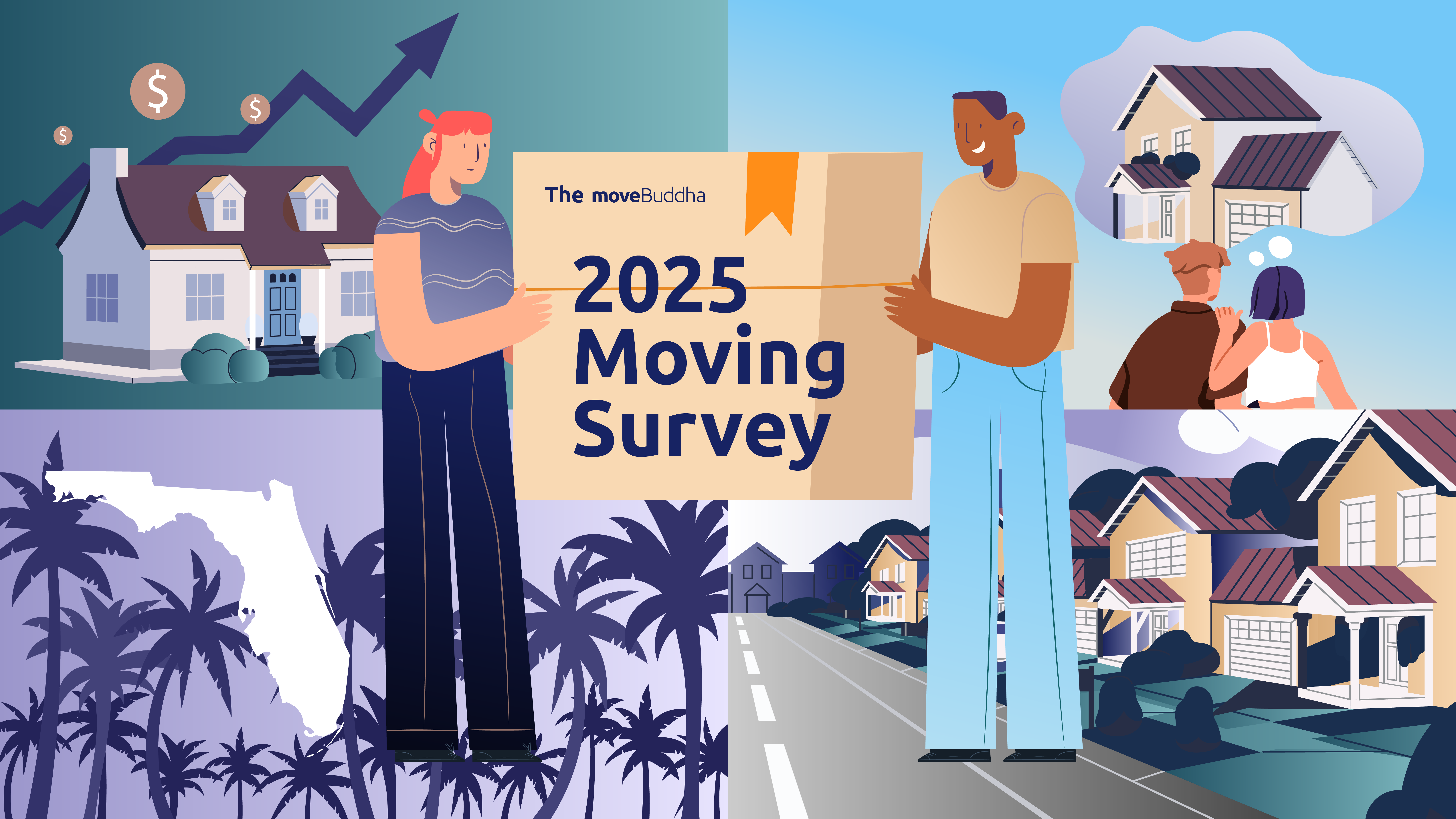moveBuddha Moving Survey: Where Americans Aspire to Move in 2025?

Americans have been moving at historically low rates, but high numbers of Americans report a desire to move. Our survey asks Americans whether they are planning to move in 2025, where they want to move, and why.
Key Takeaways
- 35% of Americans say they plan to move in 2025, but historical trends suggest only 8-9% will actually relocate.
- 1 in 4 respondents planning a move say they’ll head out of state and 4% are planning on moving to another country.
- Northeastern residents who are planning a move are 50% more likely than Westerners to move out of state in 2025.
- Florida is the most desired state to move to in 2025, with residents in three of four U.S. regions naming it as the state they’d most like to move to.
- 1 in 3 Americans want to live in the suburbs — the most popular living environment.
- 87% reported that a lower cost of living and housing affordability would motivate them to move.
Despite a decades-long decline in relocations, the desire to move is alive and well.
To understand the disconnect between aspirations and reality, we surveyed a representative sample of 1,250 Americans about their plans to move in 2025.
Our findings reveal that moving remains a key part of the American Dream, driven by the search for better lifestyles, more affordable living, and financial stability. However, as migration rates continue to fall, fewer Americans than ever are successfully turning their moving dreams into reality.
Table of Contents:
1 in 3 respondents plan to move in 2025
Florida is the most desired state for relocation
Suburbs are the most sought-after living environment
Affordability and quality of life drive moving decisions
Fewer Americans are turning moving dreams into reality
Dream vs. Reality: Over 1 in 3 Respondents Want to Relocate in 2025 (But Fewer than One-Tenth of Them Will)
Of 1,250 respondents surveyed, as many as 35% reported that they are planning a move in 2025.
Of course, this is a survey about moving intent and is not equivalent to real moves.
Once the year has passed, the real rate of moves will, in all likelihood, be closer to 8 or 9% in keeping with the decades-long development of decreasing migration.
About 1 in 4 of planned moves are out of state
While the respondents planning moves are looking further for new adventures.
28% of prospective movers say they’ll head out of state.
Among respondents who are planning a move in 2025, 68% intend to stay in-state, and more than half of those prospective movers—12% of all respondents—plan to stay within the same city limits.
| Response | % of all respondents | % of respondents moving |
| Yes, within the same city | 12% | 36% |
| Yes, same state, new city | 11% | 32% |
| Total in-state moves | 24% | 68% |
Further still, 4% are planning on moving to another country. A surge in interest in emigration is typical following presidential elections, but tends to return to normal levels after a few weeks.
Most Northeasterners aren’t moving, but those who plan a move are 50% more likely than Western residents to exit their home state
71% of respondents living in the Northeast region of the U.S. have no plans to look for a new residence in 2025.
This is the highest rate of retention of the four U.S. regions specified in the survey – with 67% of Midwesterners, 63% of Southerners, and 57% of Westerners planning to stay put this year.
But while residents of Northeastern states are the least likely to report that they plan to move in 2025, those that are planning to move are the most likely to cross state lines, with 32.8% planning to take up residency in another state.
Residents of Western states are the most likely to be planning a move in 2025. But among those with the intent to move, they are the least likely to leave for another state—just 22.5% of prospective movers in the West plan to move out of state.
To be sure, the states in the Northeast region of the U.S. are much geographically smaller than those in the Western region. Prospective movers in the Northeast may not have to move very far from their current residence in order to cross state lines.
These figures show a shift from recent trends of people leaving both densely populated areas and pricey coastal locales. Northeasterners report they are most likely to stay put, while Westerners who are moving favor in-state moves.
This shift suggests that the mass exodus from these places may now be leveling off.
Florida is the most desirable moving destination, California is #2
When it comes to relocation dreams, affordability doesn’t necessarily correlate with desirability. People are generally drawn to large, economically rich states with favorable climates and abundant opportunities.
We asked respondents, regardless of whether they are planning to relocate in 2025, which state they’d most like to move to and found that Florida and California are the most desirable destinations, with Hawaii placing third.
| Most desired states to move to | Least desired states to move to | ||
| Florida | 23.8% | Kansas | 0.9% |
| California | 23.3% | North Dakota | 1.1% |
| Hawaii | 15.4% | Nebraska | 1.1% |
| North Carolina | 14.6% | Mississippi | 1.2% |
| Texas | 13.9% | Iowa | 1.4% |
In 3 out of 4 regions Florida is the top pick, but respondents in the West prefer California
Florida is the top move-to state for every region, except in the West where California is the clear favorite. Respondents located in the West prefer California (48%) as much as the second and third most popular states combined, Arizona (23.9%) and Oregon (23.7%).
The high ranking of Hawaii in this list of the most desirable states to move to highlights the aspirational quality of the findings. The dream of island life is hugely appealing, but in reality, the Aloha State consistently ranks near the bottom for net migration each year, ranking 42nd in national net migration in 2021.
| Northeast | Midwest | South | West |
| Florida: 23.5% | Florida: 21.0% | Florida: 33.9% | California: 47.9% |
| New York: 22.5% | California: 18.6% | Georgia: 23.3% | Arizona: 23.9% |
| Pennsylvania: 21.2% | Michigan: 17.6% | North Carolina: 21.6% | Oregon: 23.7% |
| North Carolina: 18.7% | Hawaii: 15.3% | Texas: 20.0% | Hawaii: 21.3% |
| California: 15.9% | Tennessee: 14.5% | California: 17.6% | Washington: 21.2% |
Suburbs are the most sought-after living environment
Regardless of whether they plan to relocate in 2025, 29% of respondents reported they would prioritize suburban destinations in a hypothetical move, with rural areas (21%) and big metro hubs (14%) next in line.
Here, the migration aspirations of survey respondents line up with the reality.
According to the 2020 census, 53% of Americans aged 12 and older reside in suburbs. What’s more, since 2010, all major racial groups are more likely to reside in suburbs than in cities.
Suburban dreams are strongest among Northeastern respondents
Respondents in all four U.S. regions chose “a suburb with a friendly community” as their top response for the ideal living scenario.
And even though the Northeast region of the U.S. has the highest concentration of large urban centers and small cities, the suburbs beat out both of these options combined.
In fact, at 34%, Northeasterners were the most likely population group to indicate a desire to live in the suburbs.
While in the South, a preference for rural life closely rivals suburban. While suburbs remain the top choice at 26%, rural tranquility comes in a close second at 24% – the largest share won by the countryside among all regions
The West is the only region where urban living edges out rural preferences. Here, 17% of respondents said they’d prefer to live in a large metro area vs. 14% in the countryside.
Affordability and quality of life outweigh earning potential as the most compelling reasons to move
Regardless of whether survey respondents plan to move in 2025, we asked what factors might influence them to change homes this year.
87% reported that a lower cost of living and housing affordability would motivate them to move.
Home prices in America rose twice as fast in 2024 as the year before.
The nation's housing prices have risen so steeply in economic hubs that they outweigh any gains people stand to make in earnings by moving there. As such, the idea of moving for better career opportunities is losing its influence: it ranked 9th out of 11 reasons for relocating.
Instead, the promise of higher earning potential that may come with career opportunities (60% of respondents) is beaten out by promises of self-preservation. Survey respondents are sooner to move if it meant living in a safer neighborhood (79%) or escaping natural disasters (62%).
At the same time, Americans are increasingly motivated by a range of lifestyle factors when considering a move, from the environmental—more access to nature (76%), more living space (70%), a warmer climate (67%)—to the social—proximity to friends and family (67%), and culture (64%).
The survey findings suggest that Americans in 2025 are less interested in moving to make more money than they are in moving somewhere where their dollar will provide them with a better quality of life.
Americans are dreaming of a move, but fewer than ever are making it happen.
Even the highest recorded rates of real migration – a sustained trend of about 20% annual relocation during the 1950s and 1960s – are dwarfed by Americans’ desire to move this year.
And 2025 is certainly not the first year in which the intent to move has far outpaced the actual rate of moves. For instance, in 2020, about 65% of respondents to one national poll expressed they were planning to relocate in 2021, but the rate of actual moves for the year were the lowest ever recorded.
In 2012 just 11% of the population relocated. By 2022, that number fell to about 8.7% of the U.S. population, around 30 million people. In fact, the rate of relocation has been steadily tumbling for decades.
Why? An aging population, remote work, more young people living at home, difficulty in relocating two-income families, and high housing costs — all have contributed to a decline in American moves for almost 40 years now.
The gap between moving dreams and reality
There are many potential explanations for the large gap between Americans who want to move in 2025 and those who actually will.
For one, moving is often a long process.
A 2024 report from the National Association of Realtors found that it takes the average home buyer 10 weeks of actively searching for a new home before beginning the purchasing process. In particularly competitive housing markets, this could take even longer.
The 10-week figure also does not include the time needed ahead of the search to get finances in order and coordinate selling an existing home or ending a rental contract; nor does it include the time it takes to actually close the deal and get the new home ready for move-in. Many Americans who begin the process of moving in 2025 may not actually move into their new digs until 2026 or 2027.
Still, many more who may wish to move this year are unlikely to seriously begin the process of relocating.
Beyond the personal circumstances that may lead to a change of plans, in a time of inflation and economic turbulence, aspirational movers may encounter obstacles aligning finances, employment, and familial responsibilities.
Conclusion
In 2025, the American Dream is still moving — but at a slower pace than ever before.
Aspirations to relocate remain high, but the reality is that financial, logistical, and lifestyle constraints have kept the majority of Americans rooted where they are.
Our survey highlights a significant shift in priorities: Americans are less motivated by economic opportunities and more by the promise of affordable living, personal safety, and improved quality of life.
No longer is moving simply a quest for a better job or a bigger paycheck, it's increasingly about finding a place that offers balance, security, and comfort.
As the country continues to adapt to economic and societal changes, the factors shaping where and why people move will evolve — and so too will the story of the American Dream.
Not what you were looking for?
Check out other categories that can help you find the information you need!

